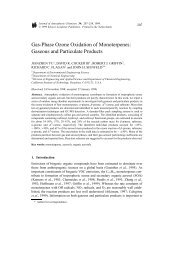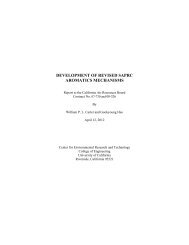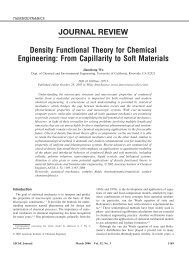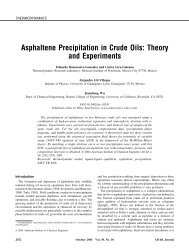A modified fundamental measure theory for spherical particles in ...
A modified fundamental measure theory for spherical particles in ...
A modified fundamental measure theory for spherical particles in ...
Create successful ePaper yourself
Turn your PDF publications into a flip-book with our unique Google optimized e-Paper software.
J. Chem. Phys., Vol. 119, No. 4, 22 July 2003 Spherical <strong>particles</strong> <strong>in</strong> microchannels<br />
2291<br />
V ext rk B T lnr 3 <br />
<br />
k B T dr <br />
n <br />
rr . 23<br />
For <strong>spherical</strong> <strong>particles</strong> conf<strong>in</strong>ed <strong>in</strong> microchannels, the density<br />
profiles are <strong>in</strong>variant <strong>in</strong> the z direction. The external potential<br />
due to the hard walls is equivalent to impose 0 outside of<br />
the boundaries.<br />
The chemical potential <strong>in</strong> Eq. 23 can be calculated<br />
from that correspond<strong>in</strong>g to a bulk fluid<br />
k B T ln b 3 b ,<br />
24<br />
where ( b ) is the derivative of the bulk residue Helmholtz<br />
energy density with respect to the bulk density b .<br />
For hard spheres, ( b ) is calculated from the Carnahan–<br />
Starl<strong>in</strong>g equation of state and <strong>for</strong> associat<strong>in</strong>g spheres, it is<br />
calculated from SAFT. A comparison of Eqs. 23 and 24<br />
yields the density profile <strong>in</strong> microchannels<br />
x,y b exp b b b <br />
dr <br />
<br />
rr. 25<br />
n <br />
As discussed <strong>in</strong> our previous works, 22,25 Eq. 25 can be<br />
solved numerically us<strong>in</strong>g the Picard-type iterative method.<br />
The weighted densities and the <strong>in</strong>tegrals <strong>in</strong> Eq. 25 are<br />
evaluated us<strong>in</strong>g Gauss <strong>for</strong>mulas because they are improper<br />
<strong>in</strong>tegrals.<br />
IV. RESULTS AND DISCUSSION<br />
We have per<strong>for</strong>med NVT simulations <strong>for</strong> neutral hard<br />
spheres of uni<strong>for</strong>m size conf<strong>in</strong>ed <strong>in</strong> a hard rectangular channel<br />
with fixed height h9 and length l14. The twodimensional<br />
density profiles and the chemical potentials<br />
with<strong>in</strong> the channel are calculated at the follow<strong>in</strong>g averaged<br />
reduced densities: av 3 0.42, 0.53, 0.66, 0.72, 0.78, 0.87,<br />
and 0.93. Here the averaged density with<strong>in</strong> the channel is<br />
def<strong>in</strong>ed as<br />
av <br />
N<br />
,<br />
26<br />
L•H•L z<br />
where N is the number of <strong>particles</strong> used <strong>in</strong> the simulation<br />
L(l1), H(h1), and L z is the length of the simulation<br />
box <strong>in</strong> the z direction.<br />
The reduced excess chemical potential of a hard sphere<br />
<strong>in</strong> the microchannel is related to the probability of successful<br />
<strong>in</strong>sertions p by<br />
ex k B T ln p.<br />
27<br />
In the orig<strong>in</strong>al particle-<strong>in</strong>sertion method proposed by<br />
Widom, 17 the test particle is identical to the real <strong>particles</strong>. In<br />
Table I, we present the probabilities of successful <strong>in</strong>sertion<br />
us<strong>in</strong>g Widom’s method at various average densities <strong>in</strong> the<br />
rectangular channel. Figure 1 presents the standard deviations<br />
<strong>in</strong> evaluation of these probabilities calculated from an<br />
error estimation method proposed by Flyvbjerg and<br />
Petersen. 27 Because the probability of successful <strong>in</strong>sertion is<br />
TABLE I. Monte Carlo simulation results <strong>for</strong> the probability of successful<br />
<strong>in</strong>sertion us<strong>in</strong>g Widom’s method, the excess chemical potentials (*<br />
ex av /k B T) from Widom’s method ( W<br />
*) and from the polynomial extrapolation<br />
us<strong>in</strong>g Eq. 1 (*), P the reduced R values <strong>in</strong> the polynomial fitt<strong>in</strong>g,<br />
and the reduced densities of the correspond<strong>in</strong>g bulk fluid with the same<br />
chemical potential from * P .<br />
av • 3 p W<br />
* P<br />
* R value b 3<br />
0.42 4.1210 2 3.19 3.19 1.0 0.445<br />
0.53 8.9310 3 4.72 4.72 1.0 0.560<br />
0.66 7.0910 4 7.25 7.25 1.0 0.693<br />
0.72 1.5110 4 8.80 8.80 1.0 0.754<br />
0.78 2.3310 5 10.67 10.68 1.0 0.814<br />
0.87 7.0010 7 14.17 14.19 1.0 0.901<br />
0.93 1.1010 7 16.02 15.97 0.9999 0.937<br />
extremely low at high density, the numerical efficiency of<br />
Widom’s method decl<strong>in</strong>es as the density <strong>in</strong>creases. In this<br />
work, we <strong>measure</strong> the probability of <strong>in</strong>sertion <strong>for</strong> a series of<br />
hard spheres with diameter d rang<strong>in</strong>g from 0.55 to . The<br />
excess chemical potential of the real sphere with diameter<br />
is extrapolated by best fitt<strong>in</strong>g of ex (d) us<strong>in</strong>g Eq. 1.<br />
Figure 2 shows the reduced excess chemical potential as a<br />
function of the diameter of the test<strong>in</strong>g particle at various<br />
average densities.<br />
From the excess chemical potential calculated from the<br />
particle <strong>in</strong>sertion method, we are able to determ<strong>in</strong>e the<br />
chemical potential and the density of the correspond<strong>in</strong>g bulk<br />
fluid from<br />
ex av k B T ln av ex b k B T ln b<br />
28<br />
and an expression <strong>for</strong> the excess chemical potential of the<br />
bulk fluid ex<br />
b from the Carnahan–Starl<strong>in</strong>g equation of<br />
state 28<br />
FIG. 1. The standard deviations <strong>in</strong> sampl<strong>in</strong>g the probability of successful<br />
particle <strong>in</strong>sertion us<strong>in</strong>g Widom’s method. The mean values of the <strong>in</strong>sertion<br />
probabilities are listed <strong>in</strong> Table I.<br />
Downloaded 14 Jul 2003 to 166.111.35.209. Redistribution subject to AIP license or copyright, see http://ojps.aip.org/jcpo/jcpcr.jsp
















